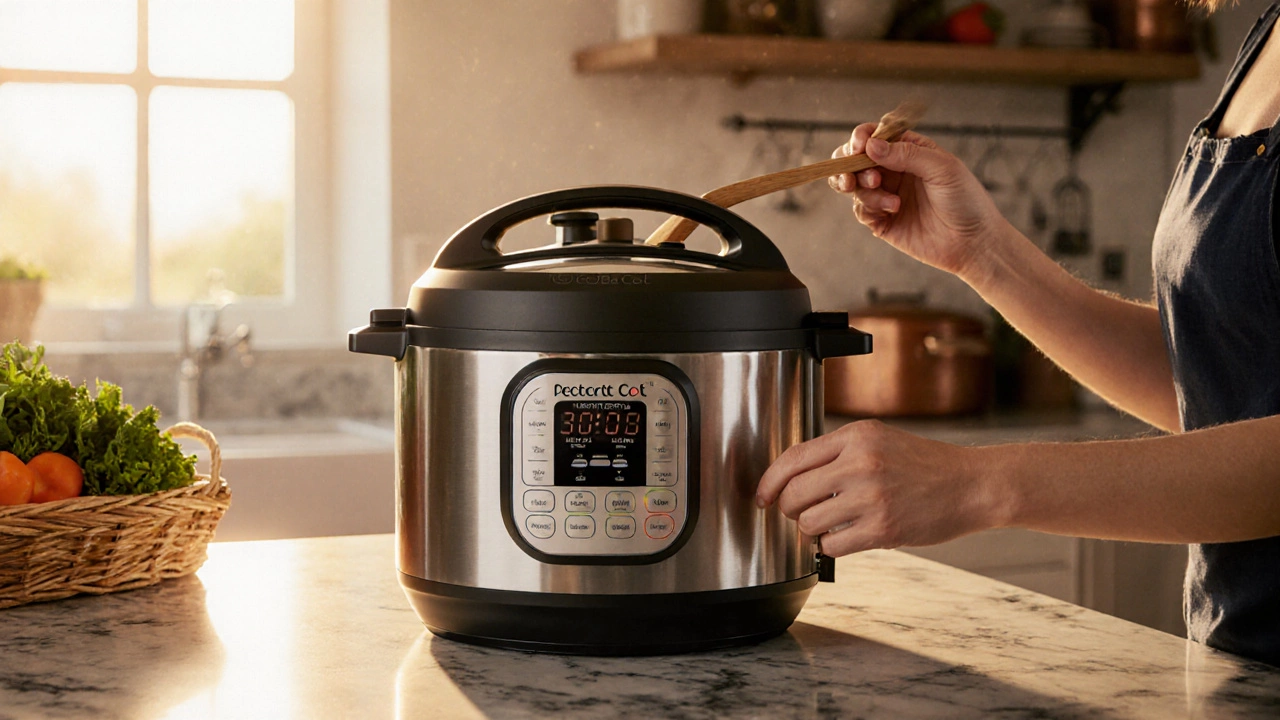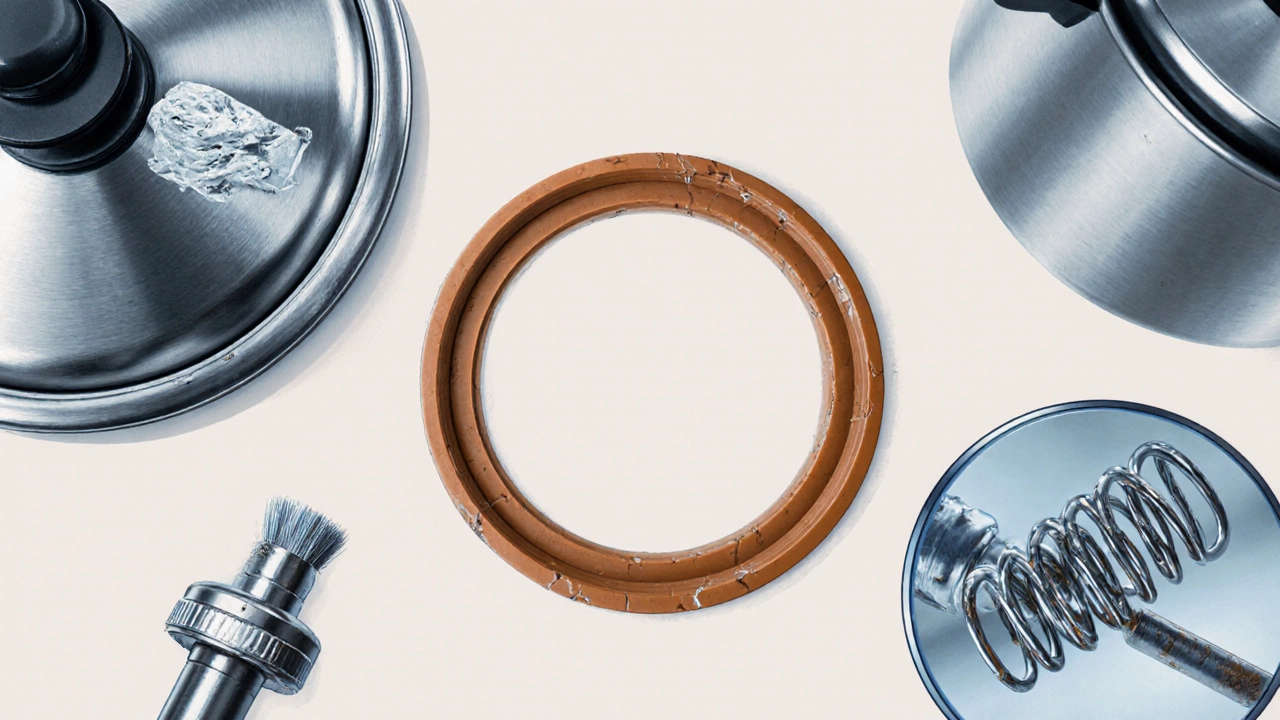
- 3 Oct 2025
- Gideon Thornton
- 0
Pressure Cooker Lifespan Calculator
Estimated Lifespan
Your made of is estimated to last approximately .
Maintenance Tips:
When you first bring a pressure cooker home, you expect it to handle stews, beans, and roasts for years. But how long do they really stick around before the seal gives out or the safety valve fails? Below you’ll find the factors that decide a cooker’s life, realistic lifespan estimates for different models, and practical steps to keep yours humming.
Quick Take
- Electric pressure cookers: 5‑8years with regular care.
- Stovetop pressure cookers: 7‑12years, especially stainless‑steel units.
- Key wear items (gasket, valve) need replacement every 1‑3years.
- Routine cleaning, proper storage, and avoiding sudden temperature changes add 2‑3years.
- When safety features fail, replace the unit rather than risk injury.
What Determines a Pressure Cooker’s Lifespan?
Pressure cooker is a sealed kitchen appliance that cooks food under high pressure, raising the boiling point of water and speeding up cooking times. Its durability hinges on three main areas:
- Build material: Stainless‑steel bodies resist corrosion longer than aluminum or non‑stick coatings.
- Mechanical components: The sealing gasket, safety valve, and pressure regulator endure repeated stress.
- Usage habits: Frequent high‑heat cycles, abrupt cooling, or over‑filling accelerate wear.
Understanding these variables helps you predict when a unit is likely to need repair or replacement.
Typical Lifespan by Type and Material
Electric pressure cooker combines a heating element, microprocessor, and sealed pot. Because of the electronic components, the average life expectancy is 5‑8years, assuming you follow the manufacturer’s cleaning routine.
In contrast, a stovetop pressure cooker relies only on external heat. Stainless‑steel models can survive 7‑12years, while aluminum versions tend to degrade after 6‑9years due to gradual metal fatigue.
| Cooker Type | Primary Material | Typical Lifespan | Key Wear Parts |
|---|---|---|---|
| Electric | Stainless steel | 5‑8 years | Sealing gasket, safety valve |
| Electric | Aluminum | 4‑6 years | Gasket, inner pot coating |
| Stovetop | Stainless steel | 7‑12 years | Lid hinges, valve spring |
| Stovetop | Aluminum | 6‑9 years | Gasket, pressure regulator |
Brand‑Specific Expectations
While material matters most, brand engineering can shift the numbers a bit. Here’s a snapshot of three popular lines as of 2025:
- Instant Pot (electric): 5‑7years, with a patented silicone gasket that tends to stretch after ~2years.
- Crock‑Pot Pressure Cooker (electric): 6‑8years, thanks to a reinforced steel housing.
- Fagor Stainless‑Steel Stovetop: 9‑12years, due to a triple‑layer lid and a heavy‑duty valve spring.
These ranges assume the owners follow the manufacturers’ cleaning and storage guidelines.

Maintenance Checklist to Extend Life
Invest a few minutes after each use and you can add years to your cooker’s pressure cooker lifespan:
- Inspect the sealing gasket (the rubber or silicone ring) for cracks, brittleness, or loss of elasticity. Replace it at the first sign of wear.
- Clean the safety valve with a soft brush; food particles can block pressure release.
- Wipe the lid’s sealing surface to prevent residue buildup that interferes with the seal.
- Avoid thermal shock: let the cooker cool naturally before rinsing with cold water.
- Store with the lid slightly ajar if you won’t use it for a while, reducing pressure on the gasket.
- Check the pressure regulator (found on stovetop models) for rust or stuck mechanisms.
For electric units, run a monthly “boil‑water” cycle without food. This clears mineral deposits that can affect the heating element.
When to Replace, Not Repair
Even the best‑kept cooker will eventually hit a point where repairs become uneconomical. Look out for these red flags:
- Repeated loss of pressure despite a new gasket.
- Corroded or warped lid that no longer seats correctly.
- Electronic failures in electric models (error codes that don’t reset after a power cycle).
- Visible cracks in the pot body-especially on aluminum units.
If two or more of these symptoms appear, budgeting for a new cooker is safer than risking a dangerous over‑pressure event.
Cost: Repair vs. Replacement
Typical repair costs vary:
- Gasket replacement: £5‑£12.
- Valve or regulator service: £15‑£30.
- Electronic board repair (electric models): £40‑£80.
A brand‑new electric pressure cooker runs between £80 and £150, while a high‑end stainless‑steel stovetop unit can cost £120‑£200. If repairs total more than half the price of a comparable new model, it’s time to upgrade.
Mini FAQ
What is the most common cause of a pressure cooker losing pressure?
A worn or mis‑aligned sealing gasket is usually to blame. Over time the rubber loses elasticity, allowing steam to escape.
Can I use a dishwasher to clean the gasket?
No. High‑heat cycles can distort the gasket. Hand‑wash with warm, soapy water and let it air‑dry.
How often should I replace the safety valve?
Inspect it every 12 months; replace it if you notice corrosion, mineral buildup, or reduced venting speed.
Are stainless‑steel lids better than aluminum lids?
Yes. Stainless steel resists warping and corrosion, which helps maintain a tight seal longer.
Is it worth buying an extended warranty for a pressure cooker?
Only if you plan heavy, daily use. For occasional home cooking, the cost of a warranty often exceeds the price of a replacement gasket.
Next Steps
If you’ve identified a worn gasket or a stuck valve, order the OEM replacement part today and follow the maintenance checklist. For units nearing the 8‑year mark with multiple wear signs, start comparing models-stainless‑steel stovetop cookers offer the longest return on investment, while electric models provide versatility and safety features.
Keeping an eye on the key components and treating the cooker gently will stretch its life, saving you both money and the hassle of a sudden breakdown.

